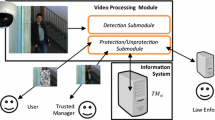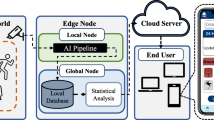Abstract
Recent advances in pervasive video surveillance systems pave the way for a comprehensive surveillance of every aspect of our lives, hence, leading us to a state of dataveillance. Computerized and interconnected systems of cameras could be used to profile, track and monitor individuals for the sake of security. Notwithstanding, these systems clearly interfere with the fundamental right of the individuals to privacy. Most literature on privacy in video surveillance systems concentrates on the goal of detecting faces and other regions of interest and in proposing different methods to protect them. However, the trustworthiness of those systems and, by extension, of the privacy they provide are mostly neglected. In this article, we define the concept of trustworthy privacy-aware video surveillance system. Moreover, we assess the techniques proposed in the literature according to their suitability for such a video surveillance system. Finally, we describe the properties that a deployment of a trustworthy video surveillance system must fulfill.


Similar content being viewed by others
Notes
For the sake of completeness, we briefly introduce the concept of compressed video. A compressed video is a set of compressed frames, grouped in GOPs (Group of Pictures). Each GOP starts with an I-frame (intra-coded) and contains several P-frames (predicted) and B-frames (bi-predictive). I-frames are stored and compressed entirely: the frame is divided into blocks; a frequency transform (e.g., Discrete Cosine Transform) is applied to each block; a quantization is applied to each block (each frequency component is divided by a number, aiming at reducing the number of discrete symbols but resulting in a lossy compression and, also, a set of zero coefficients); finally, entropy encoding (for the nonzero coefficients) and run-length encoding (for the zero coefficients) are applied for a lossless compression of the block. The information needed to reconstruct the frame is stored in a specific and standardized data structure. In addition, P- and B-frames are not stored entirely: They just consist of the changing blocks between frames in the GOP.
References
Clarke, R.: Introducing pits and pets: technologies affecting privacy. http://www.rogerclarke.com/DV/PITsPETs.html
United Nations: The universal declaration of human rights. http://www.un.org/en/documents/udhr/
Council of Europe: Convention for the protection of human rights and fundamental freedoms. http://conventions.coe.int/treaty/en/Treaties/Html/005.htm
The Trusted Computing Group: http://www.trustedcomputtinggroup.org
Senior, A. (ed.): Protecting Privacy in Video Surveillance. Springer, New York (2009)
Winkler, T., Rinner, B.: A systematic approach towards user-centric privacy and security for smart camera networks. In: Proceedings of the Fourth ACM/IEEE International Conference on Distributed Smart Cameras, pp. 133–141. ACM, New York, USA (2010)
Dufaux, F., Navarro, A., Ebrahimi, T.: Privacy enabling technology for video surveillance. In: Proceedings of SPIE—The International Society for Optics and Photonics, vol. 6250, 1 May 2006
Rowley, H.A., Baluja, S., Kanade, T.: Neural network-based face detection. IEEE Trans. Pattern Anal. Mach. Intell. 20, 23–38 (1998)
Viola, P., Jones, M.: Rapid object detection using a boosted cascade of simple features. In: Proceedings of Computer Vision and Pattern Recognition, vol. 1, pp. 511–518 (2001)
Hadid, A., Pietikainen, M., Ahonen, T.: A discriminative feature space for detecting and recognizing faces. In: Proceedings of Computer Vision and Pattern Recognition, vol. II, pp. 797–804. IEEE Computer Society (2004)
CMU/VASC Database Website: http://vasc.ri.cmu.edu/idb/html/face/index.html
Bouwmans, T., El Baf, F., Vachon, B.: Background modeling using mixture of Gaussians for foreground detection—a survey. Handbook of Pattern Recognition and Computer Vision 4(2), 181–199 (2010)
Stauffer, C., Grimson, W.E.L.: Adaptive background mixture models for real-time tracking. In: Proceedings of Computer Vision and Pattern Recognition, vol. II, pp. 246–252 (1999)
Elgammal, A.M., Harwood, D., Davis, L.S.: Nonparametric model for background subtraction. In: Proceedings of IEEE European Conference Computer Vision, pp. 751–767 (2000)
Kim, K., Chalidabhongse, T.H., Harwood, D., Davis, L.S.: Background modeling and subtraction by codebook construction. In: International Conference on Image Processing, vol. V, pp. 3061–3064 (2004)
Weickert, J., Bruhn, A., Brox, T., Papenberg, N.: A survey on variational optic flow methods for small displacements. Math. Stat. 10(I), 103–136 (2006)
Baker, S., Scharstein, D., Lewis, J.P., Roth, S., Blacket, M.J., Szeliski, R.: A database and evaluation methodology for optical flow. Int. J. Comput. Vis. 92(1), 1–31 (2011)
Lucas, B.D., Kanade, T.: An iterative image registration technique with an application to stereo vision. In: Proceedings of the 1981 DARPA Image Understanding Workshop, pp. 121–130, April 1981
Horn, B.K.P., Schunck, B.G.: Determining optical flow: a retrospective. Artif. Intell. 59(1–2), 81–87 (1993)
Farnebäck, G.: Fast and accurate motion estimation using orientation tensors and parametric motion models. In: International Conference on Pattern Recognition, vol. I, pp. 135–139 (2000)
Bruhn, A., Weickert, J., Kohlberger, T., Schnorr, C.: A multigrid platform for real-time motion computation with discontinuity-preserving variational methods. Int. J. Comput. Vis. 70(3), 257–277 (2006)
CAVIAR: Context aware vision using image-based active recognition. http://homepages.inf.ed.ac.uk/rbf/CAVIAR/
Chabrier, S., Emile, B., Rosenberger, C., Laurent, H.: Unsupervised performance evaluation of image segmentation. EURASIP J. Appl. Signal Process. (2006). http://asp.eurasipjournals.com/content/2006/1/096306
Berger, A.M.: Privacy Mode for Acquisition Cameras and Camcorders. Sony Corporation, US patent 6, 067, 399 edition (2000)
Newton, E.N., Sweeney, L., Main, B.: Preserving privacy by de-identifying face images. IEEE Trans. Knowl. Data Eng. 17(2), 232–243 (2005)
Wickramasuri, J., Datt, M., Mehrotra, S., Venkatasubramanian, N.: Privacy protecting data collection in media spaces. In: Proceedings of the 12th Annual ACM International Conference on Multimedia, pp. 48–55, October 2004
Wactlar, H., Stevens, S., Ng, T.: Enabling personal privacy protection preferences in collaborative video observation. NSF Award. http://www.nsf.gov/awardsearch/showAward.do?awardNumber=0534625
Carrillo, P., Kalva, H., Magliveras, S.: Compression independent reversible encryption for privacy in video surveillance. EURASIP J. Inf. Secur.—Special issue on enhancing privacy protection in multimedia systems, no. 5 (2009)
Tansuriyavong, S., Hanaki, S.: Privacy protection by concealing persons in circumstantial video image. In: Proceedings of the Workshop on Perceptive User Interfaces, pp. 1–4 (2001)
Cavallaro, A.: Privacy in video surveillance. IEEE Signal Process. Mag. 24(2), 168–169 (2007)
Shahid, Z., Chaumnt, M., Puech, W.: Fast protection Of H.264/AVC by selective encryption of CAVLC And CABAC for I and P frames. IEEE Trans. Circuits Syst. Video Technol. 21(5), 565–576 (2011)
Boult, T.E.: PICO: Privacy through invertible cryptographic obscuration. In: IEEE Workshop on Computer Vision for Interactive and Intelligent Environments, pp. 27–38 (2005)
Yabuta, K., Kitazawa, H., Tanaka, T.: A new concept of security camera monitoring with privacy protection by masking moving objects. In: Proceedings of International Conference on Pattern Recognition, pp. 404–407 (2005)
Martin, K., Plataniotis, K.N.: Privacy protected surveillance using secure visual object coding. IEEE Trans. Circuits Syst. Video Technol. 18(8), 1152–1162 (2008)
Cheung, S.S., Paruchuri, J.K., Nguyen, T.P.: Managing privacy data in pervasive camera networks. In: Proceedings of IEEE International Conference on Image Processing, pp. 1676–1679, October 2008
Sohn, H., AnzaKu, E.T., Neve, W.D., Ro, Y.M., Plataniotis, K.N.: Privacy protection in video surveillance systems using scalable video coding. In: Proceedings of the Sixth IEEE International Conference on Advanced Video and Signal Based Surveillance, pp. 424–429 (2009)
Dufaux, F., Ebrahimi, T.: Scrambling for privacy protection in video surveillance systems. IEEE Trans. Circuits Syst. Video Technol. 18(8), 1168–1174 (2008)
Martinez-Ponte, I., Desurmont, X., Meessen, J., Delaigle, J.: Robust human face hiding ensuring privacy. In: Proceedings of International Workshop on Image Analysis for Multimedia Interactive Services (WIAMIS). Genova, Italy (2005)
Fukuoka, N., et al.: Delivery method for viewer-specific privacy protected video using discrete wavelet transform. In: Proceedings of IEEE International Conference on Image Processing, pp. 2285–2288, October 2012
Group, T.C.: TPM main specification, v1.2, rev. 103. http://www.trustedcomputinggroup.org/resources/tpm_main_specification (2007)
Secure Real-time Transport Protocol: RFC 3177. https://tools.ietf.org/html/rfc3711
Trusted Timestamping: RFC 3161. https://tools.ietf.org/html/rfc3161
Acknowledgments
This work was partly funded by the Spanish Government through Project CONSOLIDER INGENIO 2010 CSD2007-0004 “ARES” and Project TIN2011-27076-C03-01 “CO-PRIVACY”, by the Government of Catalonia under Grant 2009 SGR 1135 and by Universitat Rovira i Virgili through Project 2012R2B-01 VIPP.
Author information
Authors and Affiliations
Corresponding author
Rights and permissions
About this article
Cite this article
Rashwan, H.A., Solanas, A., Puig, D. et al. Understanding trust in privacy-aware video surveillance systems. Int. J. Inf. Secur. 15, 225–234 (2016). https://doi.org/10.1007/s10207-015-0286-9
Published:
Issue Date:
DOI: https://doi.org/10.1007/s10207-015-0286-9




